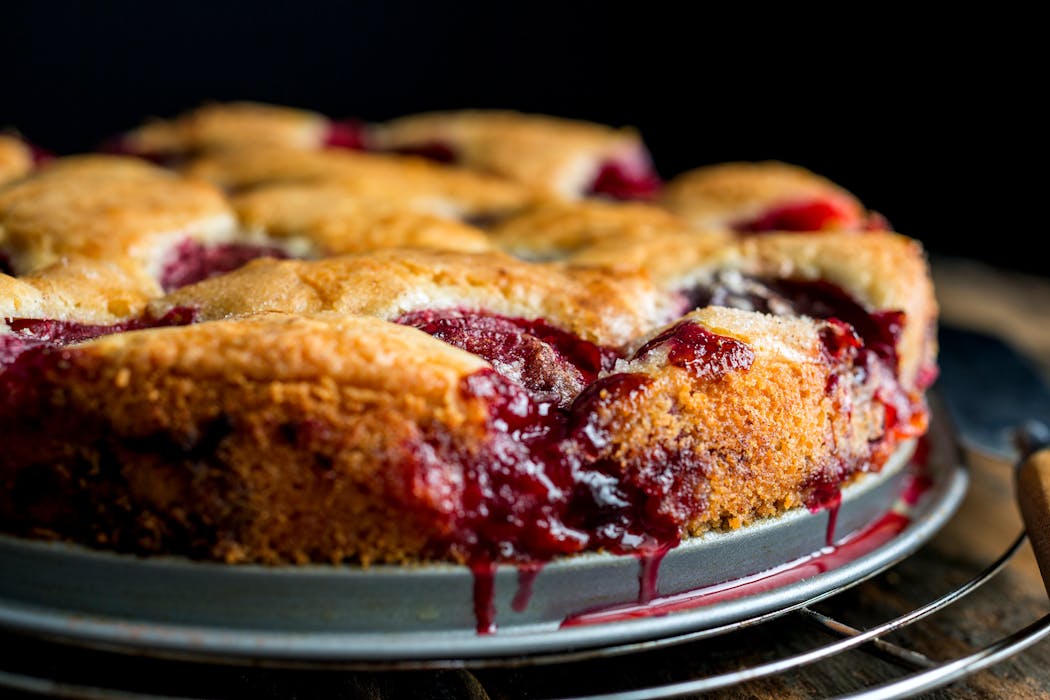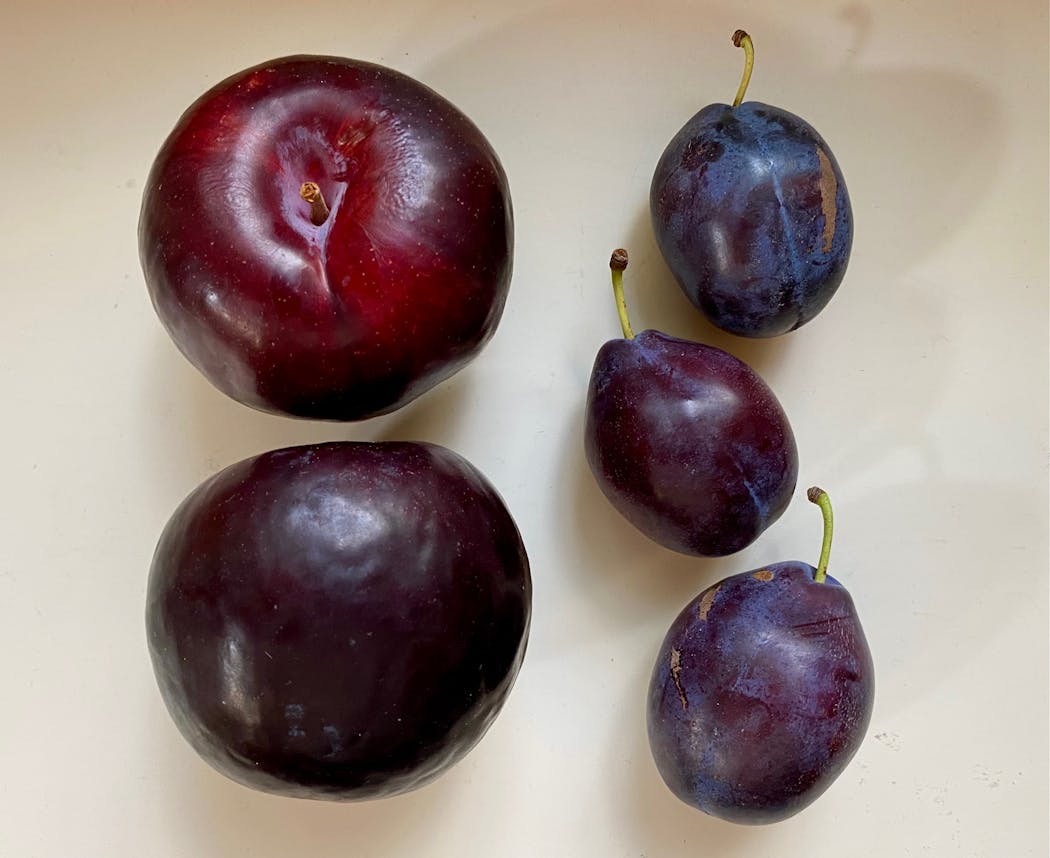I'd never tasted — let alone baked — the dazzling plum torte from the New York Times, despite its firmly entrenched role in the national baking consciousness.
Fortunately, my pal John rectified that sorry situation. He's one of the most gifted and inspiring bakers in my friend circle, and last fall showed up on our screen porch bearing a gorgeous rendition of the torte.
It was bewitchingly fragrant and still slightly toasty from the oven. One heaping forkful later, I was a convert. When I learned how easy it is to prepare, I became a zealot.
The recipe's secret weapon? Juice-laden, slightly tart Italian plums. Also known as prune plums, they're oblong, with dark purple skins, and they're smaller than their more familiar supermarket counterparts. Look for them to materialize sometime between Labor Day and Halloween.
In a cruel twist, Italian plums are also the recipe's weakness. Sadly, this is a fruit that does not enjoy the universal availability of, say, Honeycrisp apples.
"That's because there are fewer people growing them," said Matthew Schlimme, senior supply chain manager for Co-op Partners Warehouse in St. Paul, which supplies 450 stores in seven Midwestern states. "Lots of farms are getting rid of anything that's atypical, or niche or unique, and replacing them with more highly sought-after, profitable fruit."
But scarce does not equal unobtainable. I recently encountered bags of Michigan-cultivated beauties at Lunds & Byerlys.
Schlimme advised searching farmers market stands for locally grown varieties, and said that Wedge Co-op and Linden Hills Co-op in Minneapolis will likely have Italian plums on hand.
"We've found some out of Canada in the past, and some growers in Washington and California," he said. "But it tends to be a pretty expensive and nostalgic piece of fruit."
Although the torte is at its irresistible best when using Italian plums, standard-issue red plums and black plums — the juicier, the better — are wildly successful substitutes. Pluots, too.
Looking back
The recipe's back story is as compelling as its tender, buttery texture. It originated in 1962 with Lois Levine, who included it "Elegant But Easy," the cookbook she co-wrote with Marian Burros. In 1981, Burros joined the food staff at the Times and went on to have a long, influential career. Burros first shared the plum torte recipe with Times readers in 1983, and it was so popular that she republished it on nearly a dozen occasions.
In another example of the recipe's enduring appeal, requests for "plum cake" inundated editor Amanda Hesser when she was compiling suggestions for the 2021 update of "The Essential New York Times Cookbook" (Norton, $55).
"I've thought a lot about why this torte struck such a chord with people," wrote Hesser. "The answer, I think, is that it's a nearly perfect recipe. There are only eight ingredients, all of which, except for plums, you probably already have in your kitchen. There are just four steps, most of which are one sentence long. You need no special equipment. And baked plums are sweet and tart, making the flavor more complex and memorable than a hard-hitting sweet dessert."
In the Thinking Ahead department, this is a dessert that was tailor-made for freezing. After it's cooled, wrap the pan tightly in several layers of plastic wrap and then aluminum foil, pop it in the freezer and then forget about it for a few months. When snowbound January or February comes along, the glories of plum season will be just a thaw away.
Plum Torte
Serves 8.
Note: This recipe is ideal with Italian plums, also known as prune plums. Small and oval with skins that take on a purple-black color, they appear in markets in September and October. If they are unavailable, other ripe plums will do; for larger plums, use 3 to 5. Adapted from "The Essential New York Times Cookbook" by Amanda Hesser (W.W. Norton & Co., $55).
• 1 c. flour
• 1 tsp. baking powder
• Pinch of salt
• 1 c. plus 1 to 2 tbsp. sugar, divided
• 1/2 c. (1 stick) unsalted butter, at room temperature
• 2 eggs
• 8 to 12 purple Italian plums, halved, pitted and unpeeled (see Note)
• 2 tsp. freshly squeezed lemon juice
• 1 tsp. ground cinnamon
Directions
Preheat oven to 350 degrees. In a medium bowl, sift together the flour, baking powder and salt, and reserve.
In a bowl of an electric mixer on medium-high speed, beat 1 cup sugar and the butter until light and fluffy, about 2 to 3 minutes. Add the eggs, one at time, scraping down the sides of the bowl and mixing until fully incorporated. Reduce speed to low, add the flour mixture and mix until just combined.
Spoon the batter evenly into an ungreased 8- or 9-inch springform pan. Arrange the plum halves, skin side up, on top of the batter in a single layer; do not press the fruit into the batter. Sprinkle the plums with the lemon juice, then sprinkle with the cinnamon, followed by the remaining sugar, starting with 1 tablespoon and adding up to 1 more tablespoon, depending upon the sweetness of the plums.
Bake until the cake is golden, the top is lightly springy to the touch and the plums are bubbly, about 50 to 60 minutes. Remove from the oven and transfer the pan to a wire rack to cool. Unmold and serve plain, or with whipped cream or ice cream.
How to make it your own
This is one of those recipes that is reliably foolproof and remarkably flexible. Consider the following tips and tweaks:
• Add 1 teaspoon vanilla extract — or 1/4 teaspoon almond extract — when incorporating the last egg.
• Replace 1/4 cup of the all-purpose flour with an equal amount of almond flour or finely ground yellow cornmeal.
• Garnish the top with sliced almonds or a hefty sprinkle of vanilla sugar or Demerara sugar.
• Toss the sliced plums with the lemon juice (and add 1 teaspoon freshly grated lemon zest), cinnamon and remaining sugar. The extra step ensures even results, but the downside is that it dirties another bowl, and one of this recipe's most admirable attributes is its simplicity.
• Reduce the amount of sugar from 1 cup to 3/4 cup, a New York Times test kitchen suggestion from the late 1980s.
• Don't have an electric mixer? A sturdy spoon, a strong forearm and patience will yield similar results, making this an excellent cabin dessert.
• When it comes to slicing the plums, size matters. Given their diminutive stature, Italian plums can be sliced in half, but larger plums work best when cut into four, six or eight pieces.
• An 8-inch springform pan is ideal; it gives the torte an appealing height. A 9-inch pan works, too, although it creates a too-thin torte. Better to boost each ingredient by 50%. And if using a 10-inch pan, it's best to double the ingredients — although you won't need twice as many plums. Remember: Different-sized pans require slight adjustments in baking times.
• This works well with gluten-free flour. The outcome improves when up to a third of the gluten-free flour is substituted with finely ground yellow cornmeal or almond flour, or a combination of both.
• For those who can resist temptation, give the torte an overnight rest, covering the pan in plastic wrap and storing it at room temperature. That extra time allows the plums' juices to sink into the cake, accentuating the fruit's jammy texture.
New attorney joins prosecution team against Alec Baldwin in fatal 'Rust' shooting
Meta's newest AI model beats some peers. But its amped-up AI agents are confusing Facebook users
Want to celebrate 4/20? Here are 33 weed-themed events across Minnesota.
Critic's Notebook: 'Civil War' and the elusiveness of the of-the-moment movie




